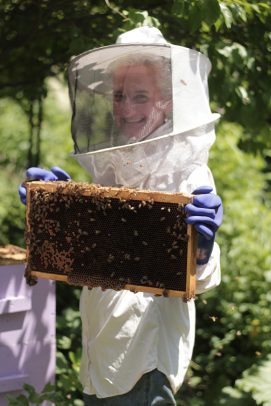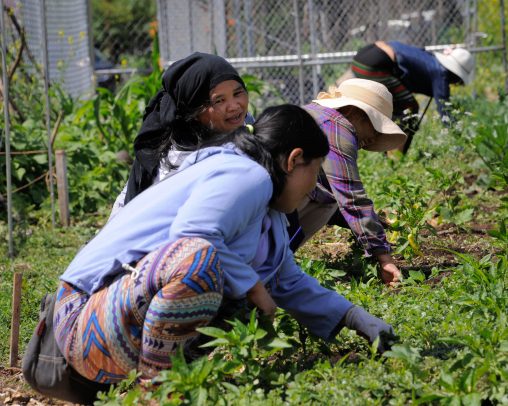East Meets West: City’s urban gardens grow sense of community
Urban gardeners across Chicago sow seeds in Pilsen plots and Albany Park garden beds, but UIC researchers say plants aren’t the only things budding in these green spaces.
“Everybody knows that gardening promotes well-being,” said Molly Doane, associate professor of anthropology. Established research shows trees can lower a person’s heart rate, for example.
“We’re interested in how it gives you agency, a sense of impact, a sense of changing your neighborhood, creating community,” Doane said.
She and an interdisciplinary team of researchers have identified and studied vital city gardens used by low-income, immigrant and refugee populations. Doane and colleagues are focusing on three garden networks on the city’s North Side, Near West Side and South Side.

Molly Doane, associate professor of anthropology, learns about community beekeeping. (Photo: Haley LeRand, UIC Anthropology)
“We’re looking at gardens, but those gardens also link to aldermen, various community centers, refugee funding agencies, anti-poverty agencies, schools with greenhouses,” Doane said. “Following the individual gardeners connects to other institutions and actions in the city.”
North Side gardens near Rogers and Albany parks have many newly arrived refugees with farming backgrounds.
“They’re people from small villages who have had to leave because of political reasons or war,” Doane said. “These gardens have become really important to them because they can practice what they know, what they’re good at, and find ways to live in Chicago positively.”
In these gardens, Joanna Michel is looking at the cultural importance of traditional foods and practices that are medicinal and nonmedicinal, gathering stories about plants that have been passed down for generations.
Stories of mustard greens, which are grown by Bhutanese people, are one example. The traditional tale linked to this plant promotes its consumption over animal products like ghee, a butter, which historically had been less accessible to most farmers or lower income families in Bhutan.
“Where people are from, what they do, that cultural training is not part of medical school,” said Michel, associate director of the Urban Medicine program. Michel is also an instructor of medical education and a two-time Fulbright award winner who has studied plant use abroad. “It’s important for health professionals to know. If a prescription is not compliant with someone’s cultural beliefs, they may not take it. It’s important to understand, raise awareness and improve culturally sensitive practice.”
Near West Side locations near Pilsen and the UIC area include mostly Latino gardeners, who use gardens to preserve cultural food heritage, which often helps with biological diversity. Near West Side and South Side gardeners, who are mostly black, are using gardening to change their neighborhoods.
“They’re really interested in how gardens can create a different narrative around neighborhoods like Englewood and create an infrastructure in the city for farming and providing food locally,” Doane said.
These gardeners see potential to provide food for community-run kitchens, public schools and park developments through the new Good Food Purchasing Program in Chicago, which requires city agencies to buy from healthy, local food systems.
Emily Minor, the project’s third leading collaborator from the department of biological sciences, is studying the biodiversity in these landscapes.
“My students and I study the plants, both intentionally grown and weeds; pollinators; dragonflies, and birds in the gardens,” Minor said. Her group is interested in the attributes that lead to higher biodiversity in these gardens.
“We’re trying to build some kind of coalition around food systems at UIC,” Michel added.
“Getting a full picture is much more comprehensive, and we can identify problems and solutions more quickly.”
Alaka Wali, a curator of North American anthropology for the Field Museum, is also an investigator on the project. Paul Bick, the project photographer, and many students and volunteers have also contributed.

